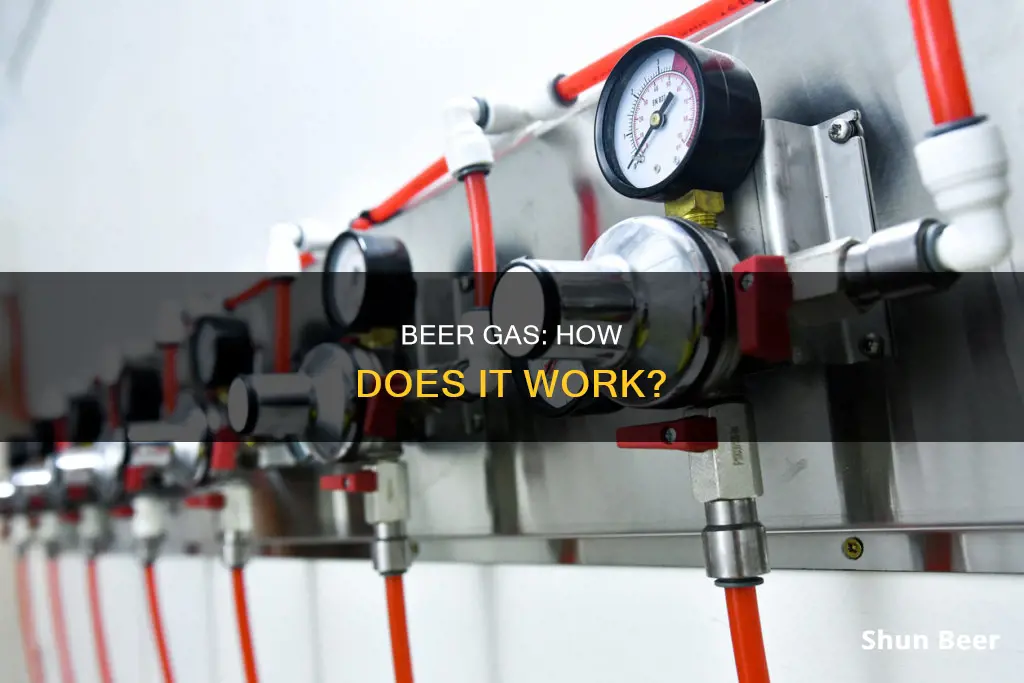
Beer gas is a blend of nitrogen and carbon dioxide used to dispense draft beer from taps. The ratio of nitrogen to carbon dioxide can vary depending on the style of beer being poured. Beers such as nitro stouts or Guinness require a higher percentage of nitrogen, which creates a creamy head and gives the beer a smooth mouthfeel. Lagers, on the other hand, often use more carbon dioxide for better effervescence and a crisp finish. The type of tap system used also plays a role, with some systems allowing brewers to adjust the mix, while others come pre-set with specific ratios for certain styles.
| Characteristics | Values |
|---|---|
| Purpose | Dispense draft beer from the taps |
| Gas Composition | Carbon dioxide and nitrogen |
| Effect on Beer | Affects the flavor and texture of the brew |
| Beer Type | Used for nitro stouts, Guinness, ales, lagers, IPAs, and craft beers |
| Carbonation | CO2 is used to carbonate the beer |
| Foam | Nitrogen helps to keep the head on the beer and prevents it from becoming too foamy |
| Taste | A higher percentage of nitrogen creates a creamy head and a smooth mouthfeel |
| Experimentation | Using different ratios allows brewers to experiment with different styles |
| Gas Blend Ratio | Based on the beer's CO2 content, temperature, and required applied pressure |
| Cylinder Blend | Pre-mixed gas cylinders are usually 25% CO2 and 75% nitrogen |
What You'll Learn
- Beer gas is a mixture of nitrogen and carbon dioxide
- It's used to dispense draft beer from the taps
- The ratio of nitrogen to carbon dioxide can vary depending on the style of beer
- It's used to keep the head on the beer and prevent it from becoming too foamy
- Using beer gas can help bring out certain flavours in your brew

Beer gas is a mixture of nitrogen and carbon dioxide
The use of beer gas can help bring out certain flavours in a brew that might otherwise be masked by bitterness or astringency from hops or maltiness from grains. It also helps create a smoother drinking experience by preventing too much fizziness from excessive levels of carbon dioxide. Additionally, using different ratios allows brewers to experiment with different styles without sacrificing quality or flavour profiles that customers expect.
When it comes to carbonating and pressurising beer, traditional methods typically use carbon dioxide to push the beer out of the tap and maintain its natural carbonation. However, if there is too much carbon dioxide, the beer will get overly foamy, and if there is too little, it will go flat. Nitrogen, on the other hand, is frequently used in conjunction with carbon dioxide to create "nitro beers", which are known for their smooth, creamy texture.
Understanding Beer Columns: Brewing Process Simplified
You may want to see also

It's used to dispense draft beer from the taps
Beer gas is used to dispense draft beer from the taps. It is a mixture of nitrogen and carbon dioxide gases, with the ratio of the two varying depending on the style of beer being poured. The gas is used to propel the beer from the keg to the tap, with the correct blend of gases maintaining the equilibrium of the beer and ensuring it does not become overly carbonated or flat.
The type of beer will determine the right blend of beer gas to use. For example, stouts such as Guinness have a higher percentage of nitrogen, which gives them a creamier head and a smoother mouthfeel. On the other hand, lagers and ales often use more carbon dioxide for better effervescence and a crisp finish.
The use of beer gas can also help bring out certain flavours in the beer that might otherwise be masked by bitterness or astringency. It also helps create a smoother drinking experience by preventing too much fizziness from excessive levels of carbon dioxide.
The ratio of gases used in beer gas can also depend on the length of the beer line from the keg to the tap. Longer lines require higher pressure to push the beer through, and beer gas with a higher percentage of nitrogen allows for this without over-carbonating the beer.
Snail Solution: Beer Trap's Effectiveness and Efficiency
You may want to see also

The ratio of nitrogen to carbon dioxide can vary depending on the style of beer
The ratio of nitrogen to carbon dioxide in beer gas can vary depending on the style of beer being poured. The ratio will impact the flavour and texture of the brew, with some beers requiring more nitrogen for a creamier head and smoother mouthfeel, and others needing more carbon dioxide for better carbonation and a crisp finish. Brewers carefully adjust the ratio of nitrogen to carbon dioxide to bring out certain flavours in their brews and create a smoother drinking experience.
Nitrogen is less soluble in beer than carbon dioxide, so it doesn't dissolve to create carbonation. Instead, it's used to push beer out of the keg while maintaining the existing carbonation level. Nitrogen is typically used with beers that are intended to be less carbonated and smoother, such as stouts or nitro cold brew coffee. Nitrogen creates a cascading effect when poured, resulting in a thick, creamy head. It also forms smaller, denser bubbles than carbon dioxide, resulting in a smoother, creamier mouthfeel.
Carbon dioxide, on the other hand, is highly soluble in water-based liquids and is primarily used in most draught beer systems to create carbonation. It gives beer its effervescence and contributes to its mouthfeel. However, using too much carbon dioxide can over-carbonate the beer, changing its flavour and making it feel more fizzy or prickly on the tongue.
The most common ratio of nitrogen to carbon dioxide in beer gas is 75% nitrogen and 25% carbon dioxide. This blend is often used for "nitro" beers, such as stouts and ales, which are known for their creamy mouthfeel and less carbonated texture. A higher percentage of nitrogen creates a creamy head on the beer, enhancing sweeter flavours and balancing out bitter or astringent notes.
For beers with higher carbonation levels, such as lagers and pale ales, a different ratio may be used. A blend of 60% carbon dioxide and 40% nitrogen is perfect for dispensing most IPAs, Pale Ales, and Lagers, providing a more stable pour at higher ambient temperatures. However, using this blend for lagers will affect the taste more over time than using a pure nitrogen gas mix.
Ultimately, the choice of gas and the ratio of nitrogen to carbon dioxide depend on the specific beer style, the desired mouthfeel, flavour profile, and serving method. In some cases, a blend of gases may be used to achieve the perfect balance, with nitrogen complementing carbon dioxide to keep the beer in equilibrium.
The Mechanics of Chugging: Beer Bong Functionality Explained
You may want to see also

It's used to keep the head on the beer and prevent it from becoming too foamy
When it comes to serving beer, the gas used can make a big difference in maintaining the perfect head and preventing excessive foaminess. This is where beer gas, a blend of nitrogen and carbon dioxide, comes into play.
The traditional way of serving beer is with carbon dioxide, which helps to push the beer out of the tap and maintain its carbonation. However, if there is too much carbon dioxide, the beer will become overly foamy, and if there is too little, it will go flat. This is a delicate balance that can be challenging to maintain.
Nitrogen, on the other hand, is not strong enough to use with most beers on its own. It will cause them to go flat. However, when combined with carbon dioxide, it creates "nitro beers," which are known for their smooth, creamy texture. This blend is often used for stouts, like Guinness, and helps to keep the head on the beer while preventing it from becoming too foamy.
The key to using beer gas effectively is finding the right ratio of nitrogen to carbon dioxide. A higher percentage of nitrogen will create a creamier head and a smoother mouthfeel, enhancing sweeter flavours and balancing out bitterness. On the other hand, higher levels of carbon dioxide will provide more fizz and a crisp finish, which is ideal for lighter styles like lagers or pale ales.
The type of beer being served determines the blend ratio. For example, nitro stouts typically require a higher percentage of nitrogen, while lagers may use more carbon dioxide. The blend ratio can also depend on other factors, such as the length of the beer lines and the distance the beer needs to travel from the keg to the tap.
Using beer gas allows brewers to experiment with different styles and bring out certain flavours that might otherwise be masked by bitterness or astringency. It helps create a smoother drinking experience and ensures that the beer is not overwhelmed by excessive fizziness from high levels of carbon dioxide.
A Beer Lover's Guide to Mohegan Sun Fest
You may want to see also

Using beer gas can help bring out certain flavours in your brew
On the other hand, higher levels of carbon dioxide will provide more fizziness and give your beer a crisp finish. This is especially desirable in lighter styles like lagers or pale ales where strong hop flavours are less prominent. Brewers often use different ratios of nitrogen to carbon dioxide when dispensing their beers depending on the style they are pouring. For example, nitro stouts use a higher percentage of nitrogen for their signature creamy head, while lagers often use more carbon dioxide for better fizziness and refreshment.
The type of tap system used to dispense the beer will also play an important role; some systems allow brewers to adjust the mix as needed while others come pre-set with specific ratios for certain styles. Using beer gas can also help create a smoother drinking experience by ensuring there isn't too much fizziness from excessive levels of carbon dioxide, which can be overwhelming. Lastly, using different ratios allows brewers to experiment with different styles without sacrificing quality or flavour profiles that customers may be expecting.
Beer Tube Screens: How Do They Work?
You may want to see also
Frequently asked questions
Beer gas is a mixture of nitrogen and carbon dioxide used to dispense draft beer from the taps. The ratio of nitrogen to carbon dioxide can vary depending on the style of beer being poured.
Beer gas works by using a blend of nitrogen and carbon dioxide to propel beer through a tap system while keeping the beer in equilibrium. The blend of gases helps to maintain the correct carbonation and pressure, preventing the beer from becoming overly foamy or flat.
Using beer gas can help bring out certain flavors in the beer that might otherwise be masked by bitterness or astringency from hops. It also creates a smoother drinking experience by reducing excess fizziness from high levels of carbon dioxide. Additionally, using different ratios of nitrogen to carbon dioxide allows brewers to experiment with different styles without sacrificing quality or flavor profiles.







